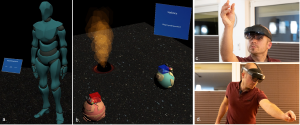Design and development of an extended reality application for preventive movement exercises
Aim and Research Question(s)
The aim of this master thesis is: „How can an extended reality application be designed and developed with an user-centered design (UCD) and gamification approach in a usable way in order to use it to address the consequences of prolonged sitting through preventive and playful movement exercises?”
Background
Along with the rise of digital technology, many people spend most of their free and working time in a sedentary lifestyle. The world health organization [1] considers physical inactivity to be among the ten leading causes of death and disability in the world. Further, a sedentary lifestyle increases all causes of mortality, doubles the risk of cardiovascular diseases, diabetes and obesity, and increases the risk of various types of cancer. According to a US study [2], it is recommended to spend not more than 3 hours in sedentary behavior and break it up to avoid negative consequences [3].
Methods
A user centered design (UCD) approach was conducted, starting with creating a questionnaire for acquiring the persona. Three iterative UCD cycles are evaluated with the System Usability Scale (SUS) for usability and the User Experience Questionnaire (UEQ) on each cycle. In the design process, a physiotherapist was included for further insights. A quality-based structured interview was used to gather important insights and to acquire further feedback.
Results and Discussion
A fully functioning prototype was designed and developed with UCD and Gamification. It includes exercises with a digital avatar and the main game component for movement exercises, targeting the neck and shoulder area. The main game component is designed for the player to reach for spawning objects, catch them, and assign them to the right dropping zone, resulting in various neck and shoulder stretches.
 Figure 1 - Range of motion warmup (a), the main game component (b) and virtual Holograms are grabbed with one hand (c) and placed inside the virtual dropping zone (d)
Figure 1 - Range of motion warmup (a), the main game component (b) and virtual Holograms are grabbed with one hand (c) and placed inside the virtual dropping zone (d)
The resulting usability testing shows a mean SUS score of 76.79 (UCD3) out of 100. The resulting scores of the User Experience Questionnaire have a possible range of +3 to -3. The scores from UCD cycle 3 were 2.2 for attractiveness, 1.5 for perspicuity, 1.5 for efficiency, 1.0 for dependability, 2.1 for stimulation and 2.5 for novelty.
Conclusion
The combination of traditional exercises and extended reality brought up an innovative way to address the negative consequences of prolonged sitting. The digital avatar performing the range of motion warmup offers a motivating way to perform the preventive movement exercises. The UCD approach with usability and user experience testing resulted in an usable, new and attractive application. Gamification and implemented game elements contributed to the motivation to use this application on a daily basis.
References
[1] Physical inactivity a leading cause of disease and disability, warns WHO. [Online]. Available: https://www.who.int/news/item/04-04-2002-physical-inactivity-a-leading-cause-of-disease-and-disability-warns-who [2] P. T. Katzmarzyk & I.-M. Lee (2012), doi: 10.1136/bmjopen-2012-000828 [3] E. Stamatakis et al. (2019), doi: 10.1016/j.jacc.2019.02.031.